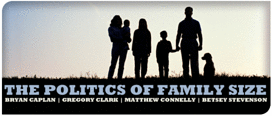Some responses to several excellent questions from Matt:
1. Matt’s concerned about the distributional effect of natalist tax credits:
Given that his policy would only apply to taxpayers, might hedge fund managers with large families get a free pass? And would this not mean doubly penalizing working class couples unable to bear children?
Actually, if the numbers I presented are remotely close to the truth, natalist tax credits would even benefit working class couples unable to bear children. My argument wasn’t merely that tax credits are a good idea all things considered. My claim, rather, is that natalist tax credits are a fiscal free lunch. Modest tax credits are enough to inspire the creation of new people who will pay far more in taxes than they’ll ever collect in services and benefits. You can question the estimates, but as I said, this free lunch is so big that you can drastically revise the numbers without changing this conclusion.
2. There is no easy answer to Matt’s toughest question:
People struggle to compare the great human rights atrocities of the 20th century, but at least we can count the bodies. How do we even begin to calculate the toll on women’s health and wellbeing of having to bear children against their will, and then compare it to the tragedy of others who were denied that right?
But I’ll try anyway:
First, it seems much more wrong to force a woman to have an abortion than to prevent her from having an abortion. I’m pro-choice, but I have to admit that the pro-life position is far from crazy. There’s at least a semi-plausible moral rationale for banning abortion. The arguments for forced abortion, in contrast, are so flimsy almost no one even bothers to make them.
Second, all else equal, coercing more people is worse than coercing fewer. And most women do not want and will not seek abortions whether or not they’re legal. But most women do want children; indeed, most want more than one.
3. Matt’s last point seems completely wrong to me:
Most people judge liberty, prosperity, and health to be good in and of themselves because they wish to live in a society that maximizes each one of them. Who wants to live in a society that maximizes fertility, especially if manipulating or pressuring couples to have more children comes at the cost of liberty, prosperity, and health?
Mathematically, as Henry Sidgwick pointed out, you can’t maximize more than one thing. And, although people may say they want to live in a society that maximizes liberty, prosperity, or health, no one would actually want to live in such a society. Why not? Because there are trade-offs. To maximize health, for example, you would have to force people to exercise and eat right—and keep ramping up the coercion until you reached the point where more coercion would actually start to hurt health. To maximize liberty, similarly, you would have to bite all the bizarre bullets that David Friedman offers in The Machinery of Freedom.
This doesn’t mean that liberty, prosperity, and health aren’t good in themselves. It just means that no one good thing should be “maximized.” Once you admit that, why not add population to the list of intrinsic goods? I’m glad to be alive. If one more person is born, he’ll probably be glad too.

